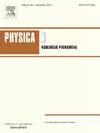Giant vortex in a harmonically-trapped rotating dipolar 164Dy condensate
IF 2.7
3区 数学
Q1 MATHEMATICS, APPLIED
引用次数: 0
Abstract
We demonstrate the formation of dynamically stable giant vortices in a harmonically-trapped strongly dipolar 164Dy Bose–Einstein condensate under rotation around the polarization direction of dipolar atoms, employing the numerical solution of an improved mean-field model including a Lee-Huang-Yang-type interaction, meant to stop a collapse at high atom density. These giant vortices are stationary, obtainable by imaginary-time propagation using a Gaussian initial state, while the appropriate phase of the giant vortex is imprinted on the initial wave function. The dynamical stability of the giant vortices is established by real-time propagation during a long interval of time after a small change of a parameter.
求助全文
约1分钟内获得全文
求助全文
来源期刊

Physica D: Nonlinear Phenomena
物理-物理:数学物理
CiteScore
7.30
自引率
7.50%
发文量
213
审稿时长
65 days
期刊介绍:
Physica D (Nonlinear Phenomena) publishes research and review articles reporting on experimental and theoretical works, techniques and ideas that advance the understanding of nonlinear phenomena. Topics encompass wave motion in physical, chemical and biological systems; physical or biological phenomena governed by nonlinear field equations, including hydrodynamics and turbulence; pattern formation and cooperative phenomena; instability, bifurcations, chaos, and space-time disorder; integrable/Hamiltonian systems; asymptotic analysis and, more generally, mathematical methods for nonlinear systems.
 求助内容:
求助内容: 应助结果提醒方式:
应助结果提醒方式:


